LINK TO HOME PAGE/CONTENTS: HOME PAGE – CONTENTS
The school provided education for grades 1 – 8. The children walked a considerable distance to school, did all the janitorial work, pumped and carried water for drinking, helped each other to learn, and in the end, with a good teacher, they did quite well.
contents ©2016 by Harold Pfohl
A GUIDE TO THE FAMILY
See: 1900 – 30s – GUIDE TO THE WILLIAM & AUGUSTA LUEDER FAMILY
WHERE THEY LIVED
Click on a map to enlarge it.
EDUCATION
The one room school was a fixture in rural American education for well over a century. Although technological advances provided electric lighting, radio, and occasional transport by car, the basic mode of operation changed little if at all, until the vast national wave of school consolidation eliminated the little country school altogether in the 1950s and 60s.
The educational system was a tutorial one with usually a dozen children (ages 6 to 13) and a woman as the teacher. Younger children were encouraged to seek assistance in their studies from older children, and all played together at recess and lunchtime. Classes were so small that slow or fast students could often progress at a rate consistent with their skills without disturbing the progress of classmates. There was a touch of the Romantic in memorization of, e.g., portions of poems by Longfellow – “Hiawatha,” “Evangeline,” etc. The children were proud of their little school and proud of what they learned.
Children also participated in chores for the school such as cleaning the blackboard, sweeping the floor after school, carrying drinking water from the pump, ringing the bell, raking leaves in autumn, and cleaning the schoolyard in spring. The chores created a proprietary sense among the children; it was their school. They kept it neat and tidy, and they took pride in it.
SHERMAN SCHOOL

Source – family photo
Sherman School (which still stands as a private residence on Western Ave. west of Cedarburg) is an example of that American classic that served so well for many decades – the one-room country school. It was radically different from today’s large elementary schools and had its own virtues, despite the fact that resources were quite modest.
WALKING TO SCHOOL – OFTEN REGARDLESS OF THE WEATHER

Source – Library of Congress, part of township map, 1915.
- Distance – home to Sherman School, round trip 2.4 miles.
- Distance – home to Immanuel Lutheran Parochial School, round trip 7.4 miles.
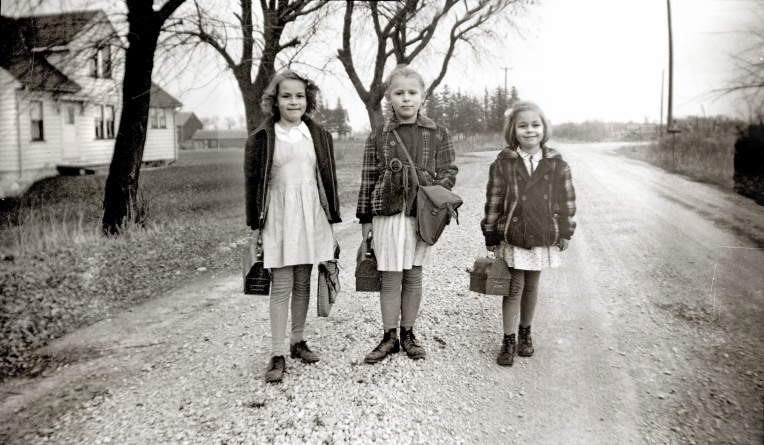
Source – family photo 1942, Walking to Sherman school in 1942, three of William and Augusta’s grandchildren. Viola’s daughters, Sylvia on the left and Vivian on the right. Edgar’s daughter Marcella in the center. Vivian’s first day at school.
At least the road was graveled. When their parents attended a generation earlier in the 1910s & 1920s it was just a dirt road, and in foul weather, a mud pit.
Parents, William and Augusta, enrolled Cordelia and Viola in first grade at the same time. They were only 14 months apart in age (Viola b. Nov 24, 1908 & Cordelia b. Jan 30, 1910). No doubt the idea was that they could keep each other company academically as well as in their daily trek to and from school.
“School started at 9 AM and we were dismissed by 4 PM.”
The Lueder children walked to and from school, in foul weather and fair. On occasion, e.g., heavy rain, Papa William would harness a horse and take them to school in their buggy.
Viola: “On rainy days Pa would take us to school with Old Bob, our buggy horse. It was fun to ride in the buggy with its top up and side curtains on. We were always glad to get a ride. Now I realize that this was extra work for Pa. He had to stop whatever he was doing and harness up the horse. It was slow traveling, for the horse could not run because of the ruts in the road.”

Source – family photo, Bridge Rd., a dirt road in 1926
Viola “in winter we were so bundled up that only our eyes showed in those days. We wore long heavy underwear and long black cotton stockings, and high buckled boots. Mother crocheted sweaters, scarves, and caps for us. She also sewed a winter coat for Cordelia and myself. Some kids wore leggings but we could not afford them. One Christmas I received a pair of leggings as a Christmas gift from my sponsor, John Mintzlaff. I was quite proud of them. I did not wear them very often. They were too precious to me.”
“The sharp brisk winter winds brought tears to our eyes when we had to walk into the wind. Our cheeks were red and so were our fingers. Even though we wore woolen gloves our hands were so cold that it was hard to hold on to our lunch pails. Honey pails or ‘Plowboy’ tobacco pails were our lunch pails.
“There were no snowplows to open the roads. We would walk in the tracks that the horses and sleds made…Along the country road snowdrifts were piled as high as the cedar fence posts along the roadside. A hard crust would form across the top of the snow banks enabling us to walk across the snow banks.”
“We were always glad to get to the school house for we knew that the teacher would have a good fire going in the furnace-like potbellied stove. It took a while for the schoolroom to warm up in subzero weather.”
“On cold frosty evenings when walking home, one could hear the telephone wires hum. We would then put our ears to the post and listen to the strange sound.”
“One bitter cold day Cordelia, Gerald and I had walked to school in the morning. During the day a snow storm blew in by the time school let out it was really bad. So Pa, sent Edgar to meet us when we went home to help us find our way home. He walked ahead of us making a path. We arrived home all right.”
“I remember so vividly, when in my first year at school, in the late fall. There were large windows on the west side of the school and I could see a lovely sunset. It was just before school left out and we sang this song that I have never forgotten: Shadows of the Evening.”
Now the day is over
Night is drawing nigh
Shadows of the evening
Steal across the sky
Youtube link for the hymn: Now the Day is Over
PHYSICAL EDUCATION
“There were no gym classes. We all got enough exercise walking to school and from games we played during recess and at the noon hour. The games we played at school were baseball, Annie, Annie, Over, a game where we threw the ball over the school building and a team on the other side would try to catch the ball and come around the building and grab one of the players. Pump, pump, pull away was also played.”
THE JANITOR
“The students were assigned jobs such as sweeping the floor, dusting the erasers and washing the blackboards, and ringing the school bell.”
CHRISTMAS PROGRAM
“December was the month where the teacher planned the Christmas program the children would present on the 23rd. This was done every year. Families of the children would come to hear the program. We recited poems, sang carols, and gave little plays. With the help of the teacher the schoolroom was decorated with paper chains made of green and red manila paper. The children drew and colored Santa Clauses and other Christmas symbols which were pasted onto the windows. We also had a Christmas tree with all the trimmings. The last few days before the 23rd we had very few classes.”
“After the program was over, the students each received a bag with nuts, candy, and apple, and orange. I know that I was afraid of stepping in front of the people and reciting a Christmas recitation. All the children knew their parts well.”
PLUMBING & ELECTRICITY – THERE WASN’T ANY
Viola: “there was no plumbing or electricity. The privies were outdoors. There were two, one for the girls and one for the boys. There was also woodshed. It was the boys’ duty to bring in wood and coal. The well was located just south of the school building. A tin cup hung on a piece of wire on the side of the pump. All pupils drank out of the same cup. In winter there was a water pail and a dipper. Kerosene lamps with reflectors were mounted high on the wall.”
SHERMAN SCHOOL INTERIOR
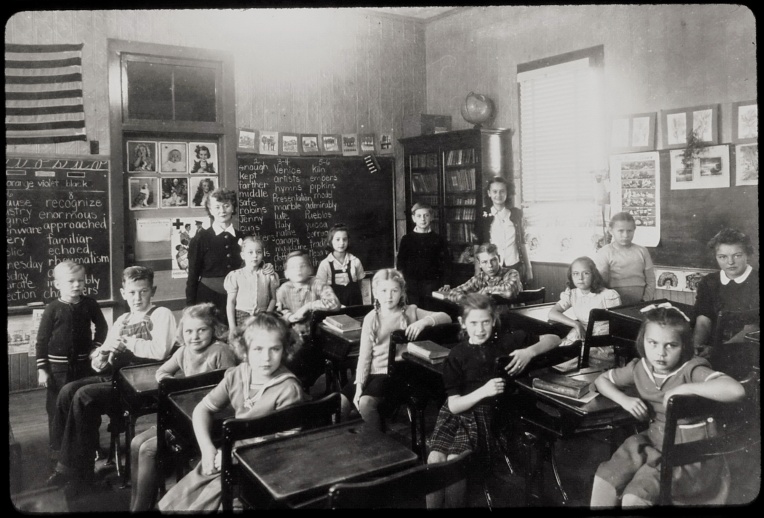 Source – family photo
Source – family photo
Interior of Sherman School, about 1942 – 43. Almost certainly the same as the interior during the preceding 30 years but with the addition of electric lighting.
LOTS OF KIDS
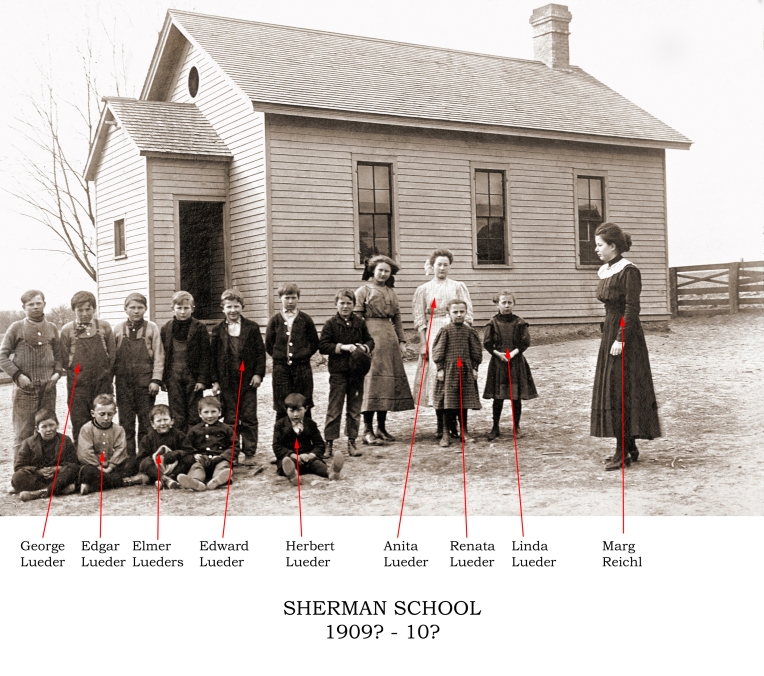 Source – family photo & with ID assistance from Steve Lueders, Sherman School students about 1908 – 1910 with teacher on the right.
Source – family photo & with ID assistance from Steve Lueders, Sherman School students about 1908 – 1910 with teacher on the right.
There were quite a few Lueders at Sherman School – The immigrant couple, Johann and Eva Dorothea Lüders had numerous great grandchildren. Only a portion of them are shown in the school picture above.
Edgar and Renata (see photo above) are the children of William and Augusta, whose family is the subject of all Section III posts concerning rural German-American life in the early 20th Century.
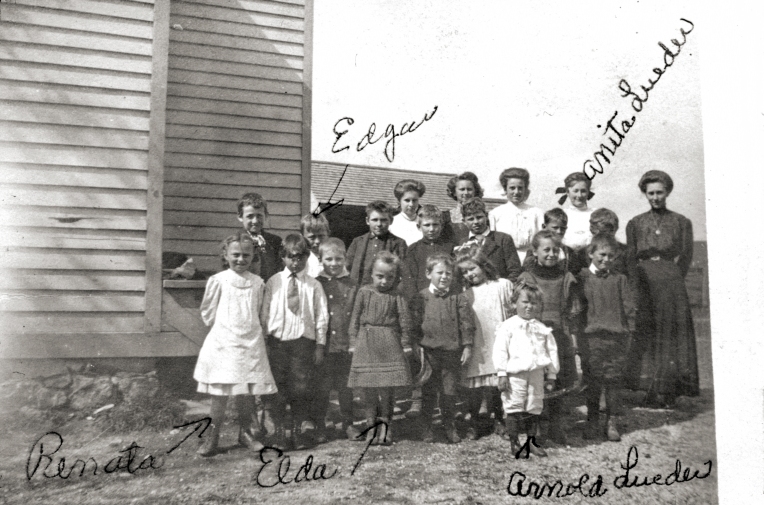
Source – Steve Lueders – Around 1911 – 1912
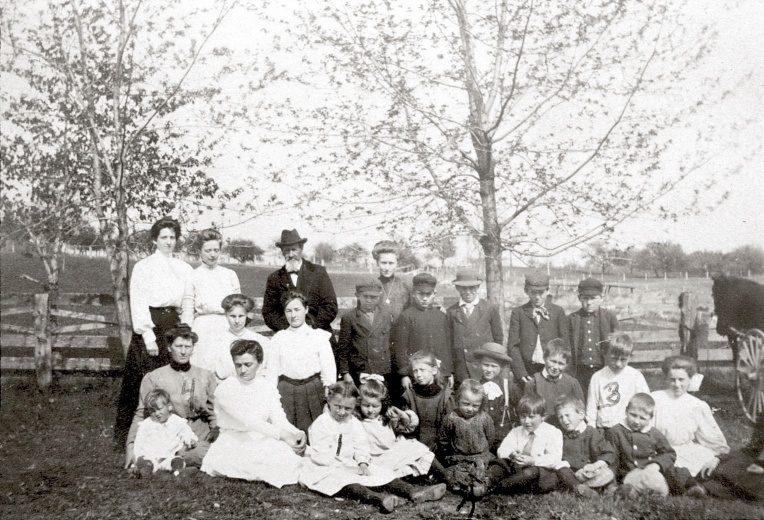
Source – family photo, about 1910 – 1911, The event is likely the annual school picnic in spring.
It includes William and Augusta’s eldest children, Edgar (10 yrs), Elda (6 yrs) and Renata Lueder (8 yrs). Renata Lueder is the 4th from the left, sitting. Edgar Lueder is the 2nd from the right in the second row, kneeling in a white shirt next to the seated lady in the . Elda Lueder is seated center front in the dark dress.
A FESTIVE OCCASION
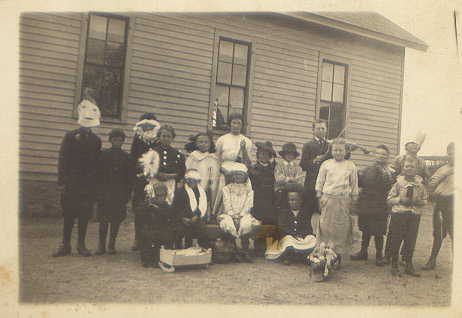
Source – Steve Lueders
Viola, kneeling at the little cradle; Elda, on the ground on the right (dark jacket/sweater),\; Renata, standing fifth from the left.
Given the costumes, the boy with the fiddle, Viola in front with the cradle…what was it? It couldn’t have had anything to do with Christmas since the children are dressed far too lightly for that time of year.
THE BOYS

Source – Steve Lueders Around 1910
Note the road – Western Avenue, in front of the school. Another dirt road, suitable for horse and wagon, but not for the soon dominant automobile.
ACADEMIC RECORDS
Source – family papers, Report card and attendance award
Click on image to enlarge it.
While a good teacher could accomplish quite a lot, it certainly required very hard work to cover the subject matter for eight grades, deal with individual learning problems, and maintain discipline. Keeping all the pieces glued together was an accomplishment and the preparatory training for teaching was very limited. That usuallyconsisted of attendance at a two year “County Normal School.” Most teachers were women, and since the professional opportunities for women were limited, some very bright young ladies became teachers, which was good fortune for the pupils.
PAROCHIAL SCHOOL, AND A WRETCHED FIFTH GRADE

Courtesy – Edward Rappold, The parochial school, a converted church.
The Lueder children’s schooling was almost entirely at the one-room country school on Western Avenue, Sherman School. Gerald (8 yrs), Cordelia (10 yrs) and Viola (12 yrs) attended Immanuel Lutheran Parochial School for the 1920-21 school year by default.
The Sherman School Board consisted of William Lueder who had seven children, a bachelor farmer, and a third farmer who was childless. In the middle of the school year in January, the teacher, Mrs. Wilhelmina Wiessbach, was earning the grand sum of $65/month and had the audacity to ask for a raise to an astronomical $75. The school board voted 2 to 1 against the raise, the teacher quit in the interest of trying to earn enough to eat, and the Lueder children walked 3.7 miles, each way, 7.4 miles round trip to and from Cedarburg in the dead of winter to attend the parochial school. One suspects that William and Augusta were more than a little steamed about that vote.
* * * * * *
Immanuel Lutheran’s original pioneer log church in Cedarburg served as the parochial school for many years. Then, in 1896, the deconsecrated second church, was moved to the location shown on the map, and became the new school. This was the school that the Lueder children attended. It served as the parochial school until 1926 when a parish hall was built which also functioned as a school. A second story had been built above the classroom in the former sanctuary and was used as an apartment for the teacher. The building was torn down on January 9, 1932 and was succeeded by Kiekhaefer’s Mercury Outboard motor factory and a municipal water tower.
Source – family photos – click on image to enlarge
Winter could be fun but not if you have to walk 7.4 miles in this going to and from school.
PAROCHIAL SCHOOL PHOTO – 1920 – 1921
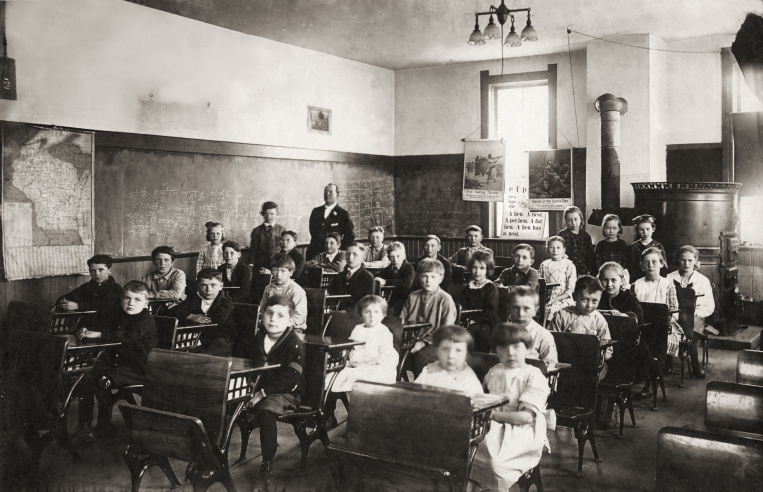
Source – family photo, Parochial School students, 1920-21 school year.
Standing in the rear: Viola Lueder on left, Cordelia in center. Right row, fourth from rear: Gerald Lueder. The overwhelmed teacher: Arthur Dauss.
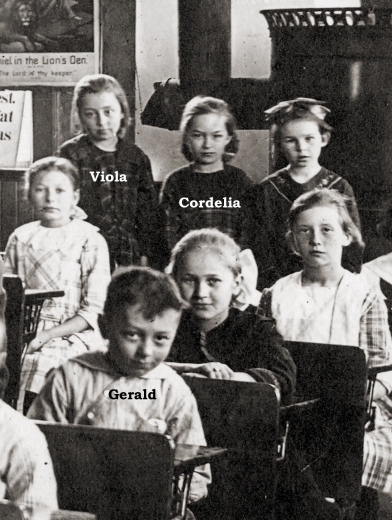
CHECK OUT THAT FURNACE!

Judging from inspection of this enlarged cropped portion of the photo, lighting on gloomy days was very limited (the fixture on the ceiling is the only one visible). And, one might reasonably conclude that on winter days, those seated in the back of the room near the huge furnace were broiled while those toward the front of the room froze.
The parochial school’s only teacher, Mr. Arthur Dauss, taught so many children that the poor man was overwhelmed and, as a result, did not really accomplish much. The photo shows 31 children in eight grades.
The Lueder children were very good students but were cash poor, and sensitive about it. In addition, in the course of walking three and a half miles to school, especially in winter, they were occasionally late and, as punishment, were made to stand in front of the class. Children being children, this resulted in ridicule. To cap it all, as good students, they realized that the quality of instruction was poor.
ZEUGNIS

Source – family papers, Zeugnis translated = mark or grade.
This is Cordelia’s report card for the parochial school year, 1920 – 1921, fifth grade. Note the left hand column, “Tage abwesend,” i.e., days absent. The weather in January and March must have been bad indeed.
THE END OF THEIR EDUCATION
The two girls graduated from grade school in 1924. Viola was 15 and Cordelia was 14. Their 8th grade teacher, Lottie Kopp, wrote a letter commending them on their grades.
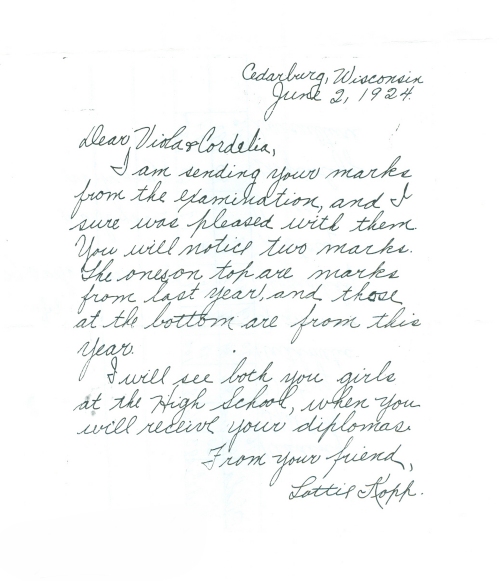
Source – family papers
GRADE SCHOOL GRADUATION EXERCISE – COUNTY WIDE

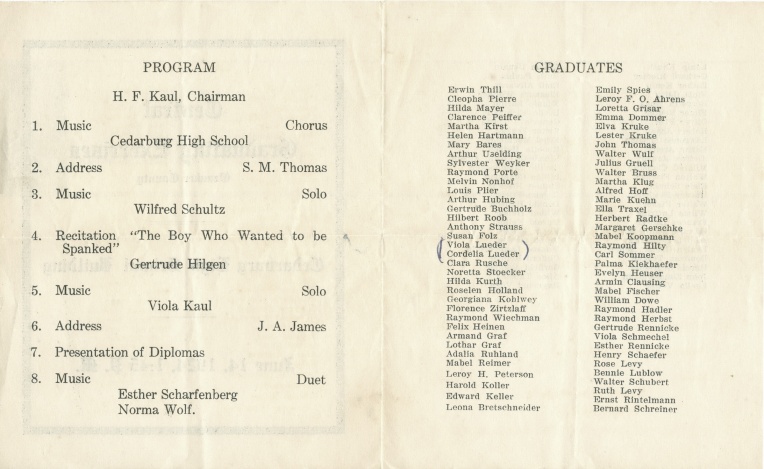 Source – family papers
Source – family papers
Note #4. Recitation “The Boy Who Wanted to be Spanked” Our culture certainly has changed over time. That would be a most curious topic for a grade school graduation today, and likely verboten.

Source – Steve Lueders
Ozaukee County grade school diploma from 1920 awarded to Viola and Cordelia’s slightly older cousin, Elmer Lueders who also attended Sherman School.
CONTINUING EDUCATION
Viola and Cordelia were excellent students. The summer after they graduated from grade school the High School principal came out to the farm to visit William and Augusta to urge that these excellent students continue their education. The girls hid from him and that was the end of it. While they would have loved to have gotten an education beyond grade school, they had experienced the 3.7 mile walk (7.4 miles round trip) to and from school for several months of the year including snow and rain. Doing that for High School was a thoroughly dismaying prospect.
That the High School principal would have made such an effort was likely unusual. Perhaps Ms. Kopp, their teacher, learned that they did not plan to continue, and, dismayed by that, talked to the principal, asking him to have a discussion with their parents.
CORDELIA – LETTER TO A FRIEND “No, we are not Freshies”

Source – family papers
“No, we are not Freshies, Viola and I. It would have been all right to go to high school as long as there is no snow, but think of the winter. To walk those 3 1/2 miles every day through snow and bad weather is no fun, maybe home in the dark sometimes.”
Why didn’t William take his children to school every day? Perhaps the problem was time. This was prior to electricity on the farm and all the morning milking and chores had to be done by hand.
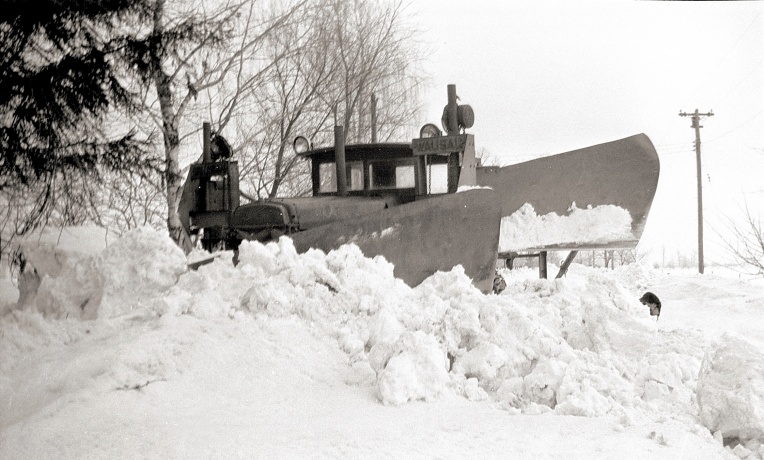
Source – family photo, Township snowplow at Lueder’s driveway.
It was uncommon for farm children to go to school beyond the 8th grade. They were often needed at home, and education at the high school level was not necessary. As discussed in the previous post, they were kept very busy with farm labor.
NO MERCY FROM MOM – AUTHOR’S NOTE
The author attended a one room country school and walked one and one quarter miles to get there in Sauk County, Wisconsin from 1948 – 1955. With rare exception, no amount of bellyaching about rotten weather would convince his Mom, Cordelia, that a ride to school was in order. Not much sympathy from that quarter. She bundled him up in long johns, scarf, stocking cap, and boots and shipped him off into the foul weather with his lunch pail. Recollection of that experience provides great appreciation for Viola and Cordelia’s reluctance to attend High School when it meant a daily seven mile walk, including bad weather and darkness.
NEXT – RELIGION AND RITES OF PASSAGE








This is my favorite post so far 🙂 Thanks for the education updates!
LikeLike
Katie – thanks. They did the best they could with what they had. More you cannot ask of anyone. And, the system was actually quite good. Ruth, Ron and I all went to a one room country school with no plumbing. We have very fond memories of it.
LikeLike